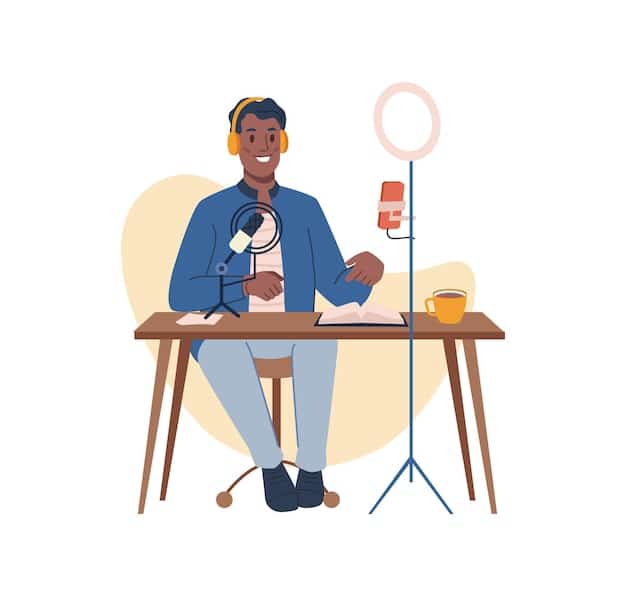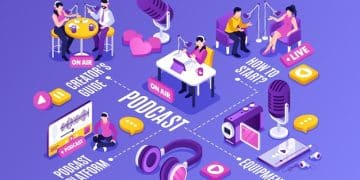Podcast Interview Follow-Up: 7-Day Strategy for ROI

Maximizing your return on investment from a podcast interview hinges on a meticulously executed seven-day follow-up strategy, transforming a single appearance into a continuous stream of engagement and opportunity.
Securing a podcast interview is a significant achievement, offering a unique platform to share your expertise and connect with a targeted audience. However, the true value of this opportunity isn’t realized the moment the recording ends. The strategic actions taken in the aftermath are paramount. This article delves into a comprehensive Podcast Interview Follow-Up: The 7-Day Strategy to Maximize Your ROI, transforming a mere appearance into a powerful engine for engagement, visibility, and long-term benefit. We will explore how a structured post-interview approach ensures every spoken word resonates far beyond the initial broadcast.
The Immediate Aftermath: Day 1-2 Post-Interview
The first 48 hours following your podcast interview are crucial for setting the stage for effective follow-up. This period is dedicated to gratitude, preliminary content capture, and internal strategic alignment. It’s an opportunity to reinforce goodwill with the host and ensure you have the raw materials for your promotional efforts.
Upon finishing the interview, a simple yet powerful act is to send an immediate, personalized thank-you message to the host. This isn’t just about politeness; it’s about building a relationship. A quick email or direct message reaffirming your appreciation for the opportunity helps solidify a positive impression. This initial touchpoint can be brief, focusing on a specific part of the conversation you enjoyed or found particularly insightful.
Capturing Key Moments and Insights
Even before the episode airs, you can start preparing. If possible, make a note of any specific points, anecdotes, or calls to action you mentioned during the recording. This will be invaluable later for creating snippets and highlight reels. Reflecting on key takeaways immediately after the interview ensures you don’t miss any valuable content that could be repurposed.
- Review your notes from the interview preparation.
- Recall any unexpected questions or topics that arose.
- Identify potential “soundbites” or memorable quotes.
Internally, communicate with your team about the upcoming interview. Inform them about its potential release date and discuss initial ideas for promotion. This ensures everyone is on the same page and can allocate resources effectively once the episode goes live. Pre-emptively discussing promotional angles can save valuable time later in the week.
Consider the potential for future collaborations. While not overtly pitching, a positive initial follow-up can subtly open doors for you to recommend other guests or even be invited back for a follow-up discussion on a related topic. Nurturing this relationship from the outset is key.
Finally, confirm with the host any release dates or specific channels where the podcast will be distributed. Knowing this information upfront allows you to plan your social media calendar and other promotional activities with precision, avoiding last-minute scrambling.
Pre-Launch Preparation: Day 3-4 Post-Interview
Days three and four are dedicated to laying the groundwork for the episode’s official launch. This involves proactive content creation and strategic planning, ensuring you have compelling material ready to share across your various platforms. The goal is to build anticipation and prime your audience for the upcoming release.
A crucial step during this phase is to obtain any pre-release assets from the podcast host. This might include an episode title, a brief synopsis, or even an audio snippet. These assets are vital for creating your own promotional content that aligns perfectly with the episode’s messaging. If the host doesn’t provide them, craft your own based on the interview’s content.

Crafting Pre-Release Content
Leverage the information you’ve gathered to start drafting social media posts, blog snippets, or email newsletter content. Focus on creating curiosity and highlighting the value listeners will gain from tuning in. Think about different angles and hooks that will resonate with your audience segments.
- Develop multiple versions of social media captions for different platforms.
- Design eye-catching graphics or quick video snippets using quotes.
- Draft a short email announcement for your subscribers.
Beyond content, establish a clear call to action (CTA) for your audience when the episode drops. Do you want them to subscribe, leave a review, visit a specific landing page, or share the episode? Having a singular, clear CTA will guide your audience and measure the success of your promotional efforts. Consistency in your messaging across all platforms is essential.
Consider reaching out to a few trusted colleagues or industry friends to let them know about the upcoming interview. They might be willing to share it with their networks once it goes live, extending your reach organically. This peer-to-peer amplification can be incredibly effective in driving early listens and engagement.
Review your personal website or landing pages to ensure they are updated and ready to receive traffic from the podcast interview. If you mentioned a specific resource or offer during the show, make sure the corresponding page is easily accessible and fully optimized for conversions. A broken link or outdated information can derail your entire follow-up strategy.
Launch Day Activation: Day 5 Post-Interview
Launch day is prime time for active promotion. This is when all your preparation culminates in a coordinated effort to drive traffic and engagement to the newly released podcast episode. The timing and consistency of your messaging are critical now.
As soon as the episode goes live, share it across all your primary social media channels. Don’t just post the link; add a compelling caption that highlights a key takeaway or an intriguing question discussed in the interview. Use relevant hashtags to increase discoverability.
- Share on LinkedIn for professional connections.
- Post snippets or quote cards on Instagram and X (formerly Twitter).
- Share the full episode link on Facebook and other relevant groups.
Engaging with the Host and Audience
Tag the podcast host and their show’s official accounts in your posts. This not only shows appreciation but also encourages them to reciprocate by sharing your posts, amplifying your reach. Engage with any comments or questions that arise on social media, fostering a sense of community around the content.
Send out an email to your subscriber list, announcing the episode’s release. Provide a direct link to the episode and reiterate the key benefits listeners will gain. A personalized touch, like briefly explaining why this particular interview is relevant to them, can significantly increase open and click-through rates.
Consider running a temporary social media ad campaign, even a small one, to boost visibility for the episode on launch day. Target audiences similar to the podcast’s existing listenership, or those interested in your specific area of expertise. A well-placed ad can exponentially increase initial listens.
If you have a blog, consider writing a companion post that expands on a specific point from the interview or provides additional resources. Embed the podcast episode directly into your blog post to encourage listenership and provide a more comprehensive content experience for your visitors.
Sustained Promotion & Engagement: Day 6-7 Post-Interview
The final days of the seven-day strategy are about long-term engagement and leveraging the initial momentum. It’s not enough to promote once; sustained effort ensures the episode continues to gain traction and generate value over time.
Repurpose the interview content into various formats. Extract key quotes and turn them into shareable image quotes for social media. Create short video clips (15-60 seconds) highlighting memorable moments from the audio or video version of the podcast. These snippets are highly shareable and can attract new listeners.
Monitoring Performance and Interacting
Keep an eye on any analytics or listener feedback provided by the podcast host. Understanding which parts of the interview resonated most can inform future content strategies and speaking engagements. If platform analytics are inaccessible, gauge engagement through social media interactions and comments.
- Track shares, likes, and comments on your promotional posts.
- Note any spikes in website traffic or lead generation.
- Monitor mentions of your name or the podcast episode online.
Beyond the initial shares, engage with new listeners who discover you through the podcast. Respond to their comments, answer their questions, and invite them to connect with you on other platforms. This personal interaction builds loyalty and converts listeners into followers or even clients.
Consider cross-promotion opportunities. Could you mention the podcast interview in an upcoming newsletter or during another speaking engagement? Integrating the interview into your broader content strategy keeps it relevant and accessible to new audiences long after the initial launch buzz has faded.
Finally, thank the host again, perhaps with a more detailed message or by sharing some positive feedback you received. This reinforces the relationship and leaves a lasting positive impression, making future collaboration more likely. A brief note highlighting its success or impact can go a long way.
Measuring ROI & Long-Term Levers
Maximizing the return on investment (ROI) from a podcast interview goes beyond immediate metrics. It involves a systematic approach to tracking, analyzing, and leveraging the interview’s impact over the long term. This strategic focus ensures that your efforts translate into tangible results for your brand or business.
Begin by defining what “ROI” means for your specific interview. Is it increased website traffic, new email subscribers, lead generation, social media growth, or perhaps brand awareness? Having clear, measurable objectives from the outset allows you to track success accurately.
- Website Traffic: Monitor unique visitors and page views to your site following the episode’s release.
- Lead Generation: Track new form submissions, demo requests, or direct inquiries.
- Social Engagement: Observe increases in follower count, mentions, shares, and comments across your social profiles.
- Email Subscribers: Note any spikes in your email list growth.
- Sales/Conversions: If applicable, link specific sales or conversions back to the podcast mention.
Utilize UTM parameters on any links you share related to the podcast to gain precise tracking data through Google Analytics or similar tools. This allows you to see exactly where your traffic is coming from and how it behaves on your site, providing invaluable insights into the effectiveness of your promotional channels.
Beyond quantitative metrics, consider the qualitative ROI. Did the interview enhance your thought leadership? Did it open doors to new networking opportunities? Did you receive positive feedback directly from listeners? These less tangible benefits are often as valuable as, if not more than, the numerical data.
For long-term leverage, consider creating an “As Seen On” or “Media” section on your website where you can proudly display your podcast appearances. This not only serves as social proof but also provides a central hub for visitors to discover your various contributions and expertise.
Periodically revisit the podcast episode. Even months after its release, it remains a valuable piece of evergreen content. You can periodically reshare it on social media, especially if it’s relevant to current events or new content you’re producing. This keeps the interview alive and continues to deliver value.
Finally, nurture the relationships built through the interview. Stay in touch with the host, offer to provide guest content for their blog, or share their future episodes. A strong network cultivated through podcasting can lead to endless opportunities for collaboration and growth.
Common Pitfalls & How to Avoid Them
Even with a well-structured follow-up strategy, common pitfalls can undermine your efforts. Recognizing these potential missteps and proactively addressing them ensures your podcast interview yields its maximum potential return. Avoiding these traps can significantly enhance your overall success.
One prevalent mistake is failing to have a clear call to action (CTA). Without explicitly telling your audience what you want them to do next, you leave them guessing. Always provide a clear, concise CTA during the interview and reinforce it through your follow-up content. Make it easy for them to take the desired next step, whether it’s visiting a specific landing page, signing up for a newsletter, or following you on social media.
Lack of Consistent Promotion
Another common pitfall is a “one-and-done” approach to promotion. Simply sharing the episode link once on launch day isn’t enough. People are bombarded with content, and a single mention can easily be missed. Develop a multi-channel, multi-day promotional plan, repurposing content and sharing snippets over time. Consistency is key to reaching a wider audience and sustaining engagement.
- Avoid posting the same message repeatedly; vary your captions.
- Spread your promotional efforts across several days or even weeks.
- Don’t forget less obvious channels like newsletters or forums.
Failing to engage with the host and their audience is a missed opportunity. Neglecting to thank the host, or not interacting with comments and questions from their listeners, can sour potential long-term relationships and limit future collaborations. Be proactive in your engagement, showing genuine appreciation and interest.
Ignoring analytics and feedback means you’re flying blind. Without tracking which promotional efforts are working and which aren’t, you can’t optimize your strategy for future interviews. Pay attention to link clicks, social media engagement, website traffic, and direct feedback to continually refine your approach.
Lastly, underestimating the power of repurposing content is a significant oversight. An interview is a goldmine of raw material. Not extracting quotes, creating video snippets, or writing complementary blog posts means you’re leaving a significant amount of value on the table. Think creatively about how each piece of the interview can be transformed into new, engaging content.
Future-Proofing Your Podcast Presence
Looking beyond the immediate seven-day strategy, future-proofing your podcast presence involves establishing sustainable practices that continuously leverage your interview appearances. This long-term perspective maximizes recurring value and solidifies your position as an authority in your niche.
One key aspect is establishing an easily accessible “media kit” or “speaker sheet” on your website. This resource should include your bio, headshot, topics of expertise, and links to past interviews. Having this prepared makes it simple for future podcast hosts or media outlets to reach out and book you, streamlining the invitation process.
Building a Centralized Content Hub
Create a dedicated section on your website, perhaps titled “Podcast Appearances” or “In the Media,” where you can embed or link to all your interviews. This not only serves as a valuable resource for your audience but also enhances your SEO, signaling to search engines your authority on these topics. Each new appearance adds to your burgeoning content library.
- Curate a list of all your podcast interviews with direct links.
- Include brief descriptions of each episode’s topic.
- Categorize by theme if you have numerous appearances.
Actively seek out opportunities for future interviews. Don’t wait for invitations; proactively pitch yourself to podcasts that align with your audience and expertise. Utilize services or directories that connect guests with hosts, and always customize your pitches to the specific show. Demonstrate how you can provide value to their listeners.
Maintain consistent communication with past hosts. A simple check-in email every few months, perhaps sharing a piece of content they might find interesting or congratulating them on a milestone, keeps the relationship warm. These connections are invaluable for repeat appearances or referrals to other podcasts.
Stay updated on podcasting trends and best practices. The audio landscape evolves rapidly, from new platforms and formats to emerging listener behaviors. Continuously learning and adapting ensures your future appearances remain relevant and impactful, reaching audiences where they are.
Finally, view each podcast interview as a chapter in your ongoing narrative. Each appearance contributes to your evolving brand story and reinforces your expertise. By consistently applying these follow-up strategies, you don’t just participate in a podcast; you build a lasting, influential presence in the audio world.
| Key Action | Brief Description |
|---|---|
| 📧 Immediate Gratitude | Send a personalized thank-you to the host within 24 hours. |
| 🚀 Pre-Launch Content | Prepare social media posts & email drafts before episode release. |
| 📈 Launch Day Blast | Share across all platforms, tag host, and engage with listeners. |
| 📊 ROI Measurement | Track website traffic, leads, and social engagement using UTMs. |
Frequently Asked Questions About Podcast Interview Follow-Up
A 7-day follow-up strategy ensures sustained engagement and maximum ROI. It moves beyond a single-day promotion, allowing for phased content distribution, audience nurturing, and data collection. This systematic approach multiplies the visibility and impact of your interview across various platforms, converting listeners into long-term followers or customers.
The most crucial step is sending a personalized thank-you note to the host within 24 hours. This gesture strengthens your relationship, showcases professionalism, and sets a positive tone for future collaborations. It’s also vital to capture immediate thoughts and key takeaways from the discussion to prepare for upcoming promotional content.
Repurposing involves transforming your interview into various media. Extract soundbites for social media graphics, create short video snippets of key moments, write blog posts summarizing main points, or adapt quotes for email newsletters. Diverse formats cater to different audience preferences and extend your content’s shelf life.
To measure ROI, track website traffic (using UTM parameters on links), new email subscribers, social media engagement (likes, shares, comments), and lead generation or sales attributed to the interview. Qualitative metrics, like positive feedback or new networking opportunities, are also important indicators of success beyond numbers.
Beyond launch day, promote snippets of the interview for several days, perhaps even weeks, varying your message and format. Reshare key insights seasonally or when relevant to current events. The goal is sustained visibility without overwhelming your audience, maintaining the content’s evergreen appeal for continued discovery.
Conclusion
A podcast interview should never be viewed as a standalone event, but rather a potent catalyst for growth that demands a strategic, disciplined follow-up. By meticulously executing a 7-day plan, from the initial thank-you to the sustained repurposing of content, you can transform a single conversation into a powerful engine for increased visibility, deeper audience engagement, and measurable ROI. The true value lies not just in what you say, but in the deliberate actions you take to ensure those words resonate long after the recording concludes, solidifying your expertise and expanding your reach within your target market.





